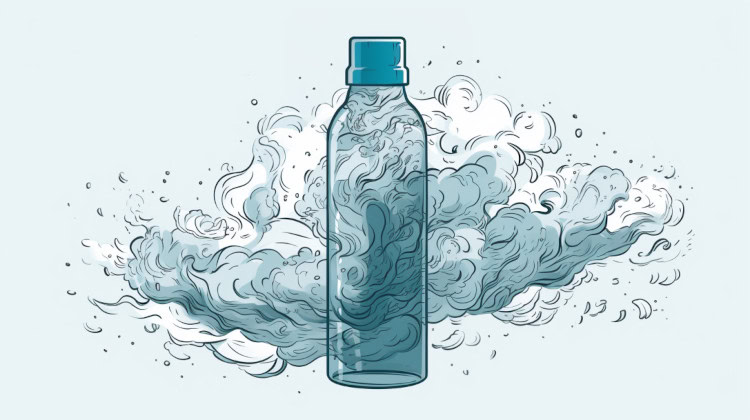In This Article
- What is a Waterfall Bong?
- Difference Between Regular, Grav, and Waterfall Bongs
- Traditional Bong
- Gravity Bong
- Waterfall Bong
- Advantages of a Waterfall Bong
- Disadvantages of a Waterfall Bong
- How to Make a Waterfall Bong
- Items You'll Need
- Steps Make a Waterfall Bong
- How to Smoke from a Waterfall Bong?
- Buying a Waterfall Bong
The waterfall bong is a perfect example of an older-era cannabis consumption method that refuses to die. The DIY method using items you can easily find at home or a convenience store has long been a favorite method for cannabis smokers looking to get sufficiently high without breaking the bank on a fancy device.
Even though there are quality options widely available in legal markets today, some people prefer the simplicity and low cost of a traditional waterfall bong. Plus, they're simple to make in just a few steps with materials you probably already have at home.
What is a Waterfall Bong?
A waterfall bong, also known as a waterfall gravity bong, is a homemade smoking device that's relatively easy to make and use. Made from a plastic bottle, waterfall grav bongs utilize water and gravity to produce substantial smoke from a single pull. An excellent choice for anyone looking to get significantly high fast, waterfall bongs are known for collecting large amounts of smoke that quickly hit the lungs once a consumer uncaps the bottle and takes in the milky white smoke.
Waterfall bongs came into popularity during the height of prohibition. Unlike today's modern smoking options, waterfall bongs were made underground using items you can find at home or are readily available in many stores without drawing any suspicion. Anyone can make a waterfall bong on at home with just the slightest precision.
Many still make their waterfall bongs at home using household items. However, legalization has allowed the item to evolve and keep up with other sophisticated commercial smoking devices. Today, you can find many waterfall bongs made by leading designers in the industry.
Difference Between Regular, Grav, and Waterfall Bongs
These three bong types share similarities, leading some to use the terminologies interchangeably and incorrectly. However, regular, gravity, and waterfall bongs have unique functionalities and selling points for consumers.
Traditional Bong
A traditional bong, or water pipe, is a device typically made from glass that uses water to cool hot smoke created by the burnt cannabis in the bong-inserted glass bowl, which is then delivered into the bong's base of water via the downstem. The smoke is cooled by traveling through the water and inhaled by the consumer, who breathes in from the bong's mouthpiece.
Gravity Bong
A gravity bong, also called a geeb, gravity pipe, gravity infuser, grav bong, etc., is made using two containers. The classic DIY model typically uses one smaller and one larger plastic bottle.
The larger bottle is filled with water roughly 1/3 of the way. The smaller bottle is placed into the water to float and bob on the liquid. The cap of the smaller bottle has a hole cut in the middle, with a metal cap for the cannabis to be placed in.
When ready, the consumer begins to light the cannabis in the bowl and slowly pulls the smaller bottle out of the water basin so that the smoke can start to fill. When ready to take in the smoke, the consumer uncaps the small bottle lid and slowly slips the small bottle into the water. As it sinks, the smoke is pushed upward, with the consumer consuming the smoke as they inhale.
Waterfall Bong
A waterfall bong uses a 2-liter bottle and a few other components below. Like a gravity bong, a waterfall contains a bowl and an opening at the top that serves as a mouthpiece. Unlike a gravity bong, a waterfall bong also has a small hole at the bottom of the bottle, which allows the water to flow out of the bong during the smoking process. Waterfall bongs require more water than a grav, often filled just below the neck.
When ready, the smoker will light their cannabis in the bowl and allow it to burn. The water inside the bottle will then be allowed to flow out of the base. As the water flows out, air replaces the space, creating smoke. When the water is gone, and the smoke amount is sufficient, the person can uncap the bottle and inhale.
Advantages of a Waterfall Bong

Some of the main advantages of waterfall bongs include:
- Simplicity: You'll be ready to go with just a few items and a few minutes.
- Cost-Effective: In most cases, a waterfall bong will set you back a couple of dozen dollars or much less, depending on what items you don't already have at home.
- Heavy Hits: A waterfall bong (or any bong) is a worthy option if you like big, smoky clouds.
- Unique Experience: Bongs are a classic cannabis smoking experience, with waterfall bongs serving as a unique consumption experience that stands out from other homemade and commercial smoke options.
Disadvantages of a Waterfall Bong
Waterfall bongs can be a blast, but like everything else, they have some potential downsides to consider:
- Made from Plastic: Waterfall bongs, mostly the DIY variety, are made using plastics, which can increase the odds of consuming harmful chemicals released when plastic is heated.
- Smoking Concerns: While cannabis isn't linked to severe lung issues like cigarette smoking, it is generally accepted that consuming any smoke presents an increased risk of lung irritation and other possible internal damage.
- Substantial Hits: Most experienced consumers won't mind the immense smoke a waterfall bong creates. But some newcomers and others with lower tolerances may find the hits overwhelming, especially since it's suggested that the smoke be taken in one or two inhales so that the smoke doesn't linger and create an often unpleasant taste.
- Single-Use Recommended: While you won't need to clean your bong, single-use plastic is a waste issue. And you'll have to make a new one every time you want to smoke or risk inhaling from a used plastic bottle.
How to Make a Waterfall Bong

Items You'll Need
- A plastic bottle (Typically, 2 liters is best, but 500ml can work for smaller hits)
- A cannabis-specific bowl or socket piece
- A lighter, hemp wick, matches, or angled torch
- Exacto-knife, knife, or other sharp object for creating small holes
- Water
- Cannabis flower
- Grinder (If your cannabis is not already ground)
- Rolling tray or other surface for easy clean up (Optional)
Steps Make a Waterfall Bong
Step 1: Make a small hole at the base of the bottle so water can flow out at a slow but steady pace.
Step 2: Cut a hole into the middle of your bottle cap. Then, insert your bowl or socket piece.
Step 3: Place a cover over the hole at the base.
Step 4: That's it! Set aside until you're ready to use.
How to Smoke from a Waterfall Bong?

You've made your waterfall bong. Now, it's time to put it to use. Here's how you smoke from it:
Step 1: Cover the hole at the bottom of the bottle, then fill it with water until almost at the neck.
Step 2: Place your ground cannabis into the bowl or socket.
Step 3: Light the cannabis with your flame. Then, quickly release the cover at the base so the water can flow.
Step 4: Allow the water to drain and smoke to form in the empty space.
Step 5: Once at a sufficient level of smoke, uncap the bottle and inhale the smoke from the opening.
Buying a Waterfall Bong
Homemade waterfall bongs are iconic and synonymous with the decades of peak prohibition of cannabis consumption. While they are still used and loved by cannabis users around the world, there are several advantages to buying a commercially made waterfall bong as well.
Products made by leading bong and smoke tech producers will set you back more money than the DIY version. However, the allure of smoking from a sophisticated, expertly crafted device made from glass undoubtedly has a strong appeal. They also come in sleeker designs, like an hourglass gravity bong, which doubles as a piece of art rather than a piece of used plastic around your house.
Whether buying a waterfall bong or making one at home, consider your smoking preferences as well as any possible risks or disadvantages that come with them; once you know the route you want to go, either head to the store and pick up the items you need or hop online and buy the device you prefer.
The information in this article and any included images or charts are for educational purposes only. This information is neither a substitute for, nor does it replace, professional legal advice or medical advice, diagnosis, or treatment. If you have any concerns or questions about laws, regulations, or your health, you should always consult with an attorney, physician or other licensed professional.




